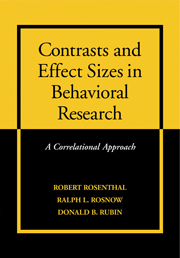4 - Contrasts in Factorial Designs
Published online by Cambridge University Press: 18 April 2011
Summary
In this chapter, we discuss planned and ad hoc contrasts in two-way and higher-order factorial designs. Our emphasis, as in the previous discussion, will be on effect size estimation, although obtaining significance levels will also be discussed. We will see that with factorial designs in which all factors are substantive, a term we define, the calculations are exactly the same as in Chapter 3. When there are nonsubstantive factors, these calculations are adjusted for the nonsubstantive factors.
PROLOGUE
This chapter is more complex than the previous chapters. At first reading, it may appear to repeat some of the earlier material because it is a detailed exposition of the application of the concepts outlined in Chapter 3 to special and complex cases that arise with factorial designs. In fact, some of these concepts really come to life in these more complex cases.
ralerting: A PRELIMINARY LOOK AT THE DATA
As in Chapter 3, we can think of ralerting as based on a one-way layout of conditions in which the condition or cell means are correlated with their associated contrast weights (i.e., their associated λs). Table 4.1 shows the means and analysis of variance of a 3 × 4 factorial design in which the column factor “number of weekly treatments” has four levels (0, 1, 2, 3) and the row factor “severity of illness” has three levels (mild, moderate, severe). The dependent variable is effectiveness of functioning.
- Type
- Chapter
- Information
- Contrasts and Effect Sizes in Behavioral ResearchA Correlational Approach, pp. 71 - 124Publisher: Cambridge University PressPrint publication year: 1999
- 1
- Cited by



